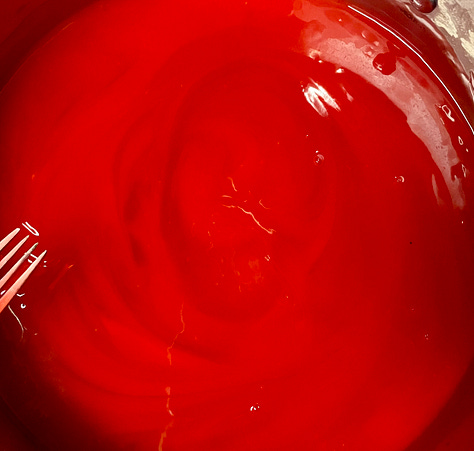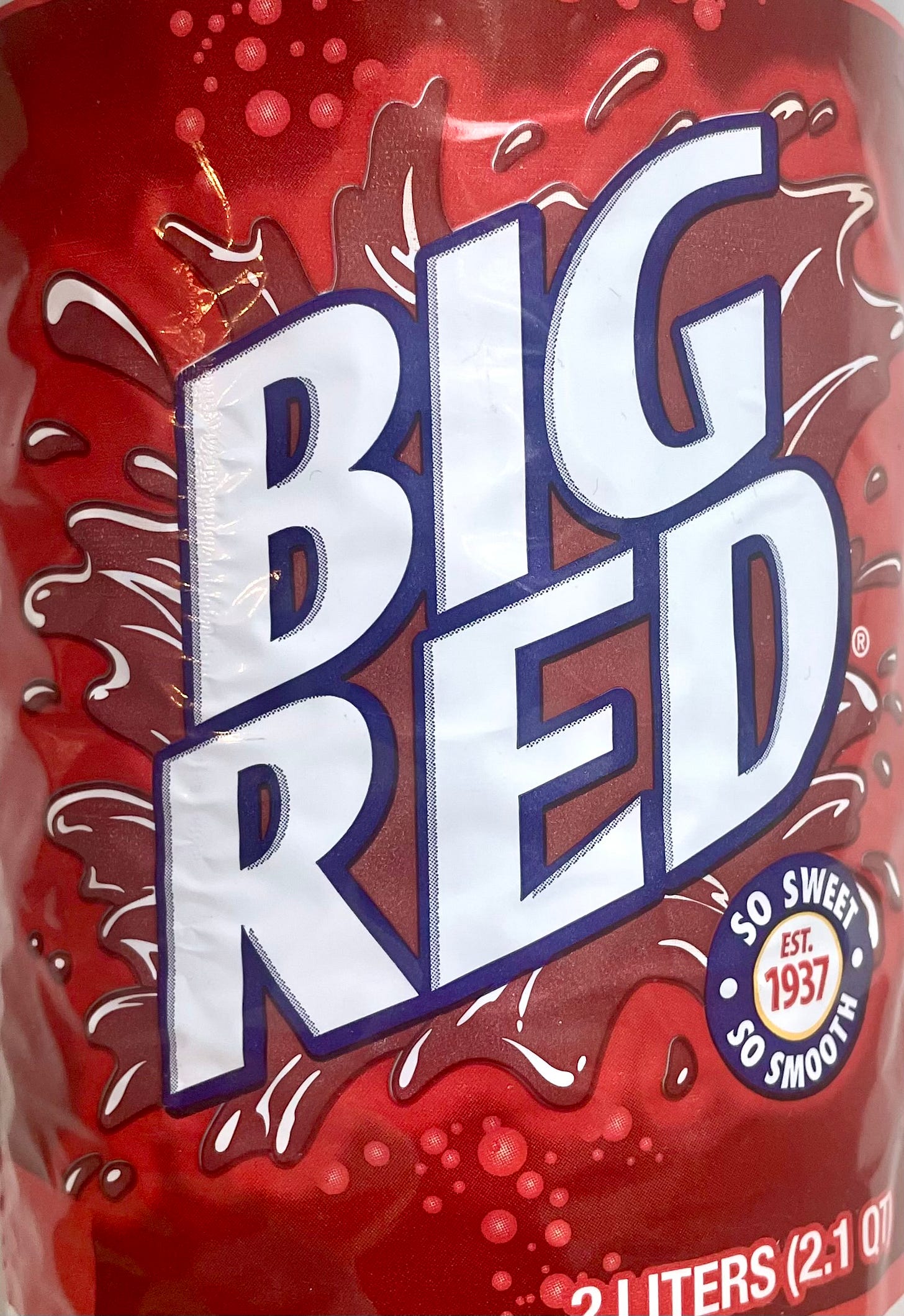It’s something of a unicorn in parts of the country, but in the South, and especially in its home state of Texas, Big Red soda is an institution in and of itself, even though these days it’s owned by Keurig-Dr Pepper. Hailing from 1930s Waco, it was originally spun off from a novelty blue cream soda, but it’s the one that caught fire in the Friendly State. Even though it doesn’t mention the old-school soda fountain pairing of Big Red garnished with boiled peanuts that I think is partially responsible for its heyday popularity, there’s a great history of it here from Texas Monthly.
What does it taste like? To me, it tastes like July at the Gulf Coast. The flavor is typically characterized as cream soda with lemon and orange elements, but there’s an undeniable and indescribable redness to it. Could it be a trick of the light? Sure. Maybe if you close your eyes, it would be indistinguishable from the cream soda next to it, but I’ve never been able to bring myself to limit the experience thusly. Big Red is in the heart, and it deserves full-bodied engagement with its majesty.
Clear eyes, warm hearts, can’t lose.
Of all the current line’s flavors, Big Peach and Big Pineapple are certainly worth a try, and trying the Blue is critical just for context, but somehow none of them hold a candle to the Red, either in distribution or grace. The best one is the retro, which is made from cane sugar but even harder to come by.
So, fresh off the sweet catastrophe of my Baja Blast Pie experiment, I’ve resolved to refine the endeavor into something far more Texas than anything even tangentially related to Taco Bell could dream of: Big Red Pie.
It’s a great opportunity to explore recipe development, too, because having fun in the kitchen, knowing full well it might be an unmitigated disaster, can actually help you with learning to approach other kinds of cooking with humor and ease…maybe even vegetables!
When attempting a new recipe of my own creation, I consider flavor, appearance, texture, and stability when choosing ingredients. Obviously the main flavor should be Big Red, but as I’ve discovered with other recent forays into soda desserts, the flavors are dampened without carbonation. I’ll be keeping its foundational flavors of cream and citrus in the back of my mind, and I’m going to start with a far more concentrated soda than I have previously.
As for appearance, I want it to be transparent. The opaqueness of the Baja Blast Pie resulted in a creamy flavor, but it lost some of the beauty of the drink. I’ll do a swirl of white using marshmallow creme and cream cheese for interest. Gelatin is the obvious choice, but with a high-acid concentrated soda, it wouldn’t gel. It’s a good idea to take a look at a primer of different thickeners when you’re choosing one (I like this one from The Kitchn), and because I want one that is easily available, not chalky, clear, and stable to heating, I'm choosing arrowroot. Another benefit to that ingredient is that there are lots of traditional recipes from its West Indian and Asian roots that give guidance to advisable ratios, and I see it has also been used in high acid foods like Feel Good Foodie’s lemon pudding.
The potentially disgusting drawback here might be texture. Like potato starch, arrowroot can be stretchy and glue-like in high concentrations. I’m hoping using a similar amount to the duddali dessert linked above will guard against that, but since it’s stable to freezing, I can keep my options open. If it’s too thin, I can freeze it for a different style of dessert, but hopefully one that’s still fun.
Since this will be a cold pie along the lines of chocolate or lemon, I’ve chosen to do a graham crust in a springform pan, so here are the remaining ingredients, minus the butter and sugar for the crust…and minus one late-breaking addition I’ll cover in a minute:
A full pie requires 4 cups of filling or more, so I’m reducing the 2 liters of soda down to 3 1/2 c by simmering, and making a little over 1 c of marshmallow cream swirl. It’s hard to decide, but after doing a little test batch, I elected to try a middle of the road ratio of arrowroot to soda, more than for the pudding recipe and less than for the duddali. I may regret it, but I’m adding a 1/2 c of arrowroot.
As it simmered, it started to look horrifyingly like ketchup and I experienced some flashbacks, but it cleared really nicely. I tasted it, though, and as I had worried, it’s…flat. I added some salt and acid in the form of True Lemon crystallized citric acid, and it put the flavor about where I wanted it while still staying in the Big Red neighborhood. It doesn’t totally replicate the particular flavor of carbonation, but it does do something.



I swirled the marshmallow cream and cream cheese mixture through and chilled, hoping for the best. After several hours, it was thick, but I worried it would run too much when sliced, and it definitely had a rubber cement pullback when touched. So I partially froze it, and I could not be happier with the result. You could try making it with duddali ratios and use about 3/4 c of arrowroot to 3 1/2 cups of reduced soda, but I think that juuuuust barely frozen serving was ideal. It slices well that way, and the mouthfeel is fabulous. I also tried letting a slice thaw entirely — it actually did hold together, and the texture was not even a little bit Elmer’s adjacent. The perfect combination of joy and horror, classic and kitsch, it would be a triumph for Juneteenth or July 4th or…Mayday, Mayday!
The overall effect is something like a minimally-meringued lemon pie, but that ineffable, unbearable redness of red quality? It’s still got it, baby.
And so do you, if you want to try making it!
Big Red Pie
graham cracker crust of your choice (I like this one and suggest pressing it only into the bottom of a springform pan with oiled bottom AND SIDES, but — say it with me — storebought is fine)
2 L Big Red, reduced to about 3 1/2 cups
1/2 c arrowroot starch
1/8 tsp salt
2 tsp lemon powder such as True Lemon
1 7 oz. jar marshmallow creme or fluff
2 oz. cream cheese
Simmer the soda on medium heat until reduced, watching carefully. It is helpful to choose your pan, pour 3 1/2 c of water in and note where it reaches on the side of the pan, or mark a chopstick at the right depth. Let cool to warm.
Scoop out about 1/2 c of soda and add the arrowroot, salt, and lemon powder. Mix into the rest of the soda and return to heat, stirring constantly especially when it starts to simmer. Cook for a few minutes until completely clear. Avoid whisking vigorously since it will introduce more bubbles. Set aside.
Heat marshmallow and cream cheese together in a bowl for about 30 seconds in the microwave, and stir until smooth. Spread 1/2 c of this mixture in the bottom of the crust carefully, so that the crumbs don’t get spread into the cream too much (this will make the red color really pop). It helps if it’s really warm, so return to the microwave for 15 seconds or so if needed. Pop into the freezer for a few minutes to stabilize, but the soda filling needs to still be warm when you fill it, so not too long.
Pour the red soda filling on top of the cream layer, and drop the remaining marshmallow mixture in about 5 big spoonfuls on the top. Draw a knife or skewer through to swirl.
Chill at least several hours or overnight, but if you want a more solid pie, consider freezing at least partially. If fully frozen, let stand at room temp one hour before slicing.
Pudding variation: Omit crust and pour soda filling directly into 8x8 pan or individual serving dishes. Swirl marshmallow through as directed above, and chill several hours.






